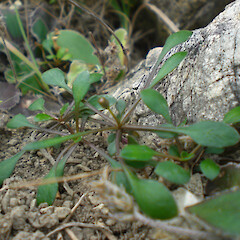Wahlenbergia albomarginata subsp. flexilis
Common name
Ward harebell, Marlborough harebell
Synonyms
Wahlenbergia flexilis Petrie, Wahlenbergia simpsonii J.A.Hay
Family
Campanulaceae
Flora category
Vascular – Native
Endemic taxon
Yes
Endemic genus
No
Endemic family
No
Structural class
Herbs - Dicotyledons other than Composites
Chromosome number
2n = 36
Current conservation status
The conservation status of all known New Zealand vascular plant taxa at the rank of species and below were reassessed in 2017 using the New Zealand Threat Classification System (NZTCS) – more information about this can be found on the NZTCS website. This report includes a statistical summary and brief notes on changes since 2012 and replaces all previous NZTCS lists for vascular plants.
Please note, threat classifications are often suggested by authors when publications fall between NZTCS assessment periods – an interim threat classification status has not been assessed by the NZTCS panel.
- Conservation status of New Zealand indigenous vascular plants, 2017 . 2018. Peter J. de Lange, Jeremy R. Rolfe, John W. Barkla, Shannel P. Courtney, Paul D. Champion, Leon R. Perrie, Sarah M. Beadel, Kerry A. Ford, Ilse Breitwieser, Ines Schönberger, Rowan Hindmarsh-Walls, Peter B. Heenan and Kate Ladley. Department of Conservation. Source: NZTCS and licensed by DOC for reuse under the Creative Commons Attribution 4.0 International licence.
2017 | At Risk – Naturally Uncommon | Qualifiers: RR, Sp
Previous conservation statuses
2009 | At Risk – Naturally Uncommon
2004 | Range Restricted
Distribution
Endemic. New Zealand: South Island (Eastern Marlborough (coastal south of Cape Campbell to just south of Kaikoura Peninsula, and inland from the coast to the Clarence Fault))
Habitat
Mostly coastal, but extending into montane areas up the Clarence River. Common on beach gravel and limestone outcrops, bluffs and hillslopes
Detailed description
Perennial herb with radical, rosulate tufts of leaves, sometimes alternate on elongated stems (shade form). Leaves more or less petiolate, entire (only dentate in deep shade), lamina 10 × 2 to 40 × 10 mm, prostrate leaves ovate to orbicular-spathulate (sometimes tufted along the elongating ascending stems in shade forms), gradually narrowed to petiole as long as the lamina or longer. Flowers insect-pollinated, narrowly campanulate-rotate, corolla pale flax creamy white to blusih-white, 18-25 mm diameter, 10-20 mm long, corolla tube 4 × 3 to 10 × 6 mm, lobes 6 × 3 to 12 × 5 mm; style equal in length to corolla tube, lobes 2 or 3. Calyx lobes less than ¼ corolla length, toothed and recurved in mature capsules; capsule domed cylindric, 6-8 × 4 mm. Seeds 0.5 mm long, ellipsoid, smooth, glossy brown when mature.
Similar taxa
Similar to subsp. albomarginata, from which it differs by the prostrate leaves which are ovate to orbicular-spathulate, sometimes tufted along the elongating ascending stems in shade forms; and by the usually entire leaf margins, (except in deep shade when they may become dentate); larger creamy white to bluish white flowers; which when fresh are 18-25 mm rather than 10-20 mm diameter.
Flowering
November – April
Flower colours
Cream, White
Fruiting
December - April
Propagation technique
Easily grown from tip cuttings and the division of whole plants. Fresh seed germinates readily. Being insect-pollinated and having an indigenous pollinator, cultivated plants rarely set seed.
Threats
A naturally uncommon, narrow range endemic that is sparsely distributed over a wide area eastern Marlborough. Although not considered threatened, some populations suffer from browsing caused by sheep, goats, rabbits hares and other livestock.
Etymology
wahlenbergia: Named in honour of Wahlenberg, a Swedish botanist and author of A Botany of Lapland.
albomarginata: From the Latin albus ‘white’ and marginatus ‘having a border or margin’ meaning something with a white margin, often referring to leaves
Where To Buy
Not Commercially Available
Attribution
Fact Sheet Prepared by P.J. de Lange 12 June 2007. Description adapted from Petterson (1997).
References and further reading
Petterson, J.A. 1997: Revision of the genus Wahlenbergia (Campanulaceae) in New Zealand. New Zealand Journal of Botanv 35: 9-54.
NZPCN Fact Sheet citation
Please cite as: de Lange, P.J. (Year at time of access): Wahlenbergia albomarginata subsp. flexilis Fact Sheet (content continuously updated). New Zealand Plant Conservation Network. https://www.nzpcn.org.nz/flora/species/wahlenbergia-albomarginata-subsp-flexilis/ (Date website was queried)

